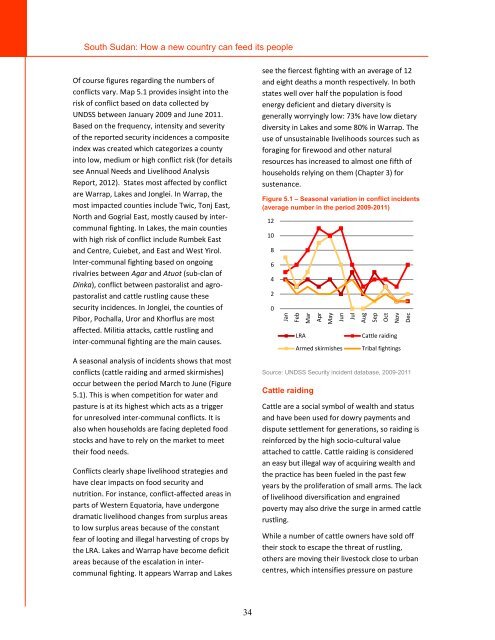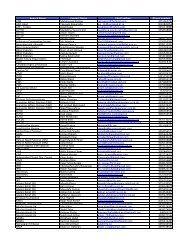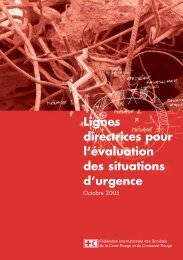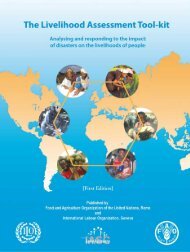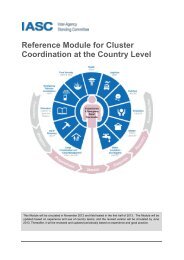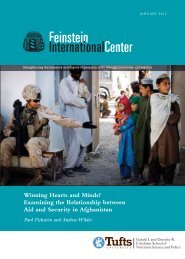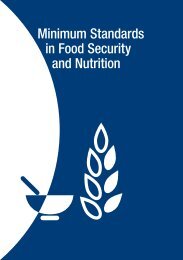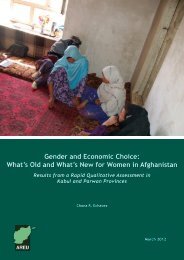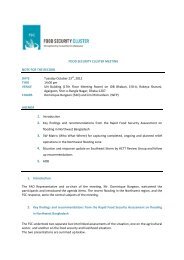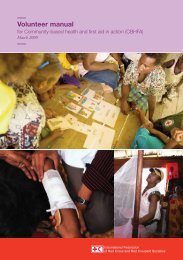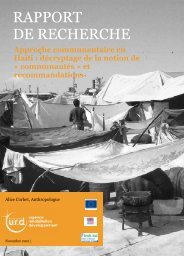4.15 MB - Food Security Clusters
4.15 MB - Food Security Clusters
4.15 MB - Food Security Clusters
- No tags were found...
Create successful ePaper yourself
Turn your PDF publications into a flip-book with our unique Google optimized e-Paper software.
JanFebMarAprMayJunJulAugSepOctNovDecSouth Sudan: How a new country can feed its peopleOf course figures regarding the numbers ofconflicts vary. Map 5.1 provides insight into therisk of conflict based on data collected byUNDSS between January 2009 and June 2011.Based on the frequency, intensity and severityof the reported security incidences a compositeindex was created which categorizes a countyinto low, medium or high conflict risk (for detailssee Annual Needs and Livelihood AnalysisReport, 2012). States most affected by conflictare Warrap, Lakes and Jonglei. In Warrap, themost impacted counties include Twic, Tonj East,North and Gogrial East, mostly caused by intercommunalfighting. In Lakes, the main countieswith high risk of conflict include Rumbek Eastand Centre, Cuiebet, and East and West Yirol.Inter-communal fighting based on ongoingrivalries between Agar and Atuot (sub-clan ofDinka), conflict between pastoralist and agropastoralistand cattle rustling cause thesesecurity incidences. In Jonglei, the counties ofPibor, Pochalla, Uror and Khorflus are mostaffected. Militia attacks, cattle rustling andinter-communal fighting are the main causes.A seasonal analysis of incidents shows that mostconflicts (cattle raiding and armed skirmishes)occur between the period March to June (Figure5.1). This is when competition for water andpasture is at its highest which acts as a triggerfor unresolved inter-communal conflicts. It isalso when households are facing depleted foodstocks and have to rely on the market to meettheir food needs.Conflicts clearly shape livelihood strategies andhave clear impacts on food security andnutrition. For instance, conflict-affected areas inparts of Western Equatoria, have undergonedramatic livelihood changes from surplus areasto low surplus areas because of the constantfear of looting and illegal harvesting of crops bythe LRA. Lakes and Warrap have become deficitareas because of the escalation in intercommunalfighting. It appears Warrap and Lakessee the fiercest fighting with an average of 12and eight deaths a month respectively. In bothstates well over half the population is foodenergy deficient and dietary diversity isgenerally worryingly low: 73% have low dietarydiversity in Lakes and some 80% in Warrap. Theuse of unsustainable livelihoods sources such asforaging for firewood and other naturalresources has increased to almost one fifth ofhouseholds relying on them (Chapter 3) forsustenance.Figure 5.1 – Seasonal variation in conflict incidents(average number in the period 2009-2011)121086420LRASource: UNDSS <strong>Security</strong> incident database, 2009-2011Cattle raidingArmed skirmishesCattle raidingTribal fightingsCattle are a social symbol of wealth and statusand have been used for dowry payments anddispute settlement for generations, so raiding isreinforced by the high socio-cultural valueattached to cattle. Cattle raiding is consideredan easy but illegal way of acquiring wealth andthe practice has been fueled in the past fewyears by the proliferation of small arms. The lackof livelihood diversification and engrainedpoverty may also drive the surge in armed cattlerustling.While a number of cattle owners have sold offtheir stock to escape the threat of rustling,others are moving their livestock close to urbancentres, which intensifies pressure on pasture34


